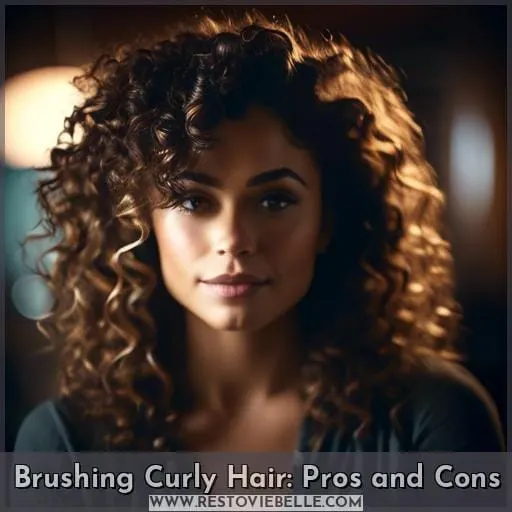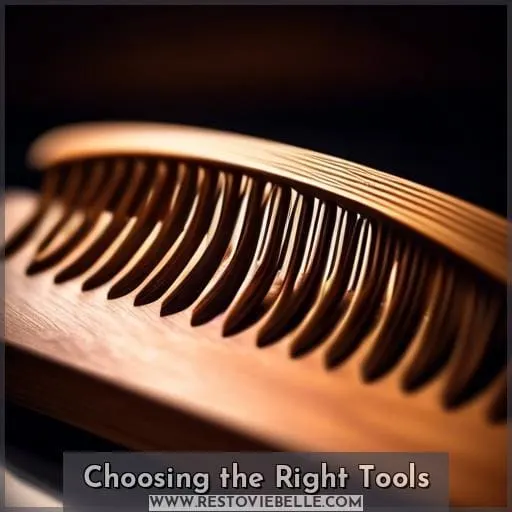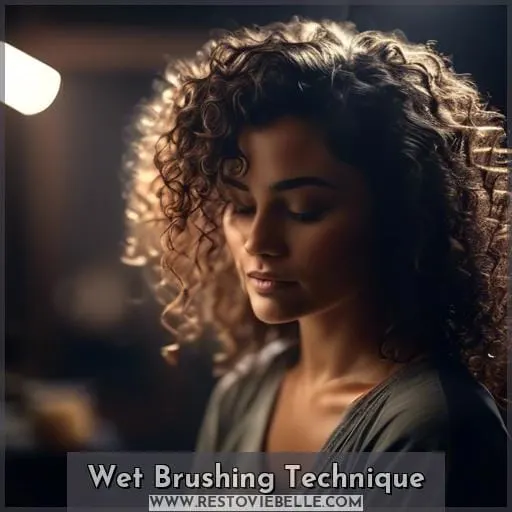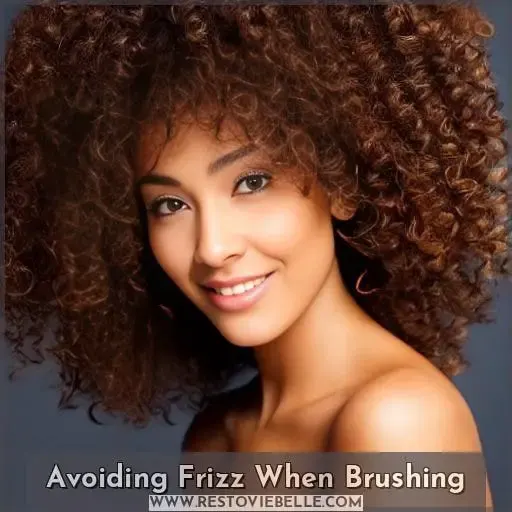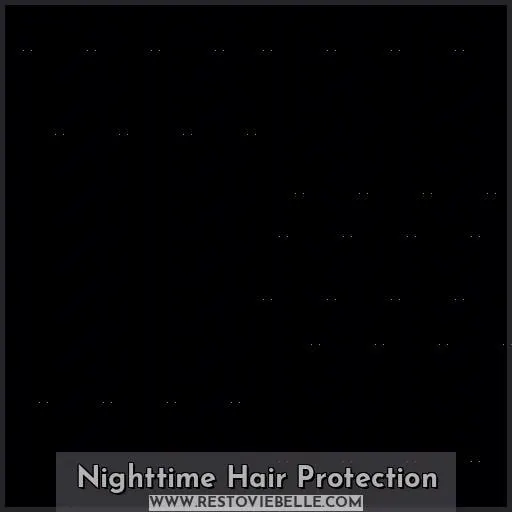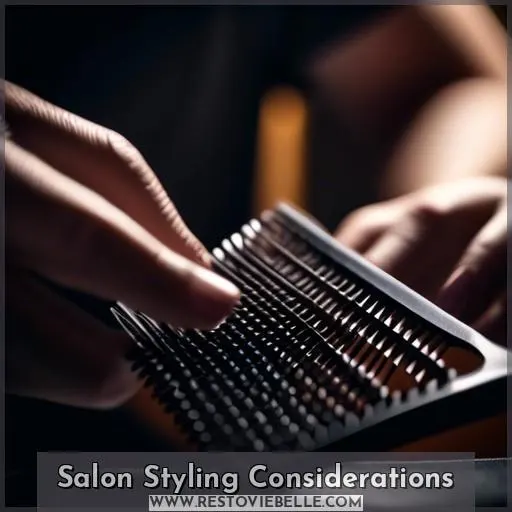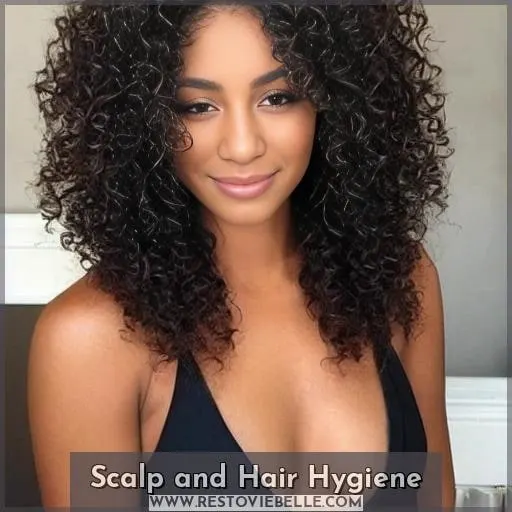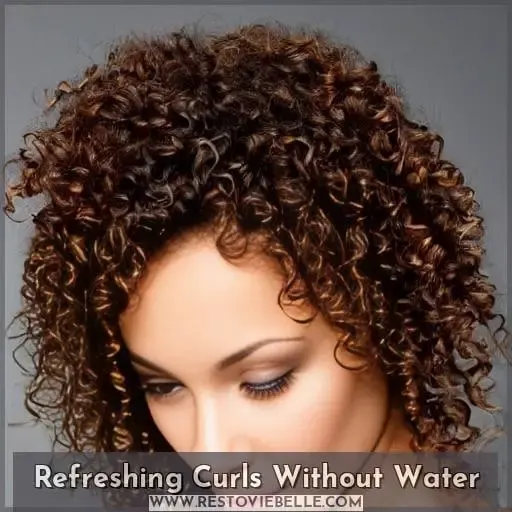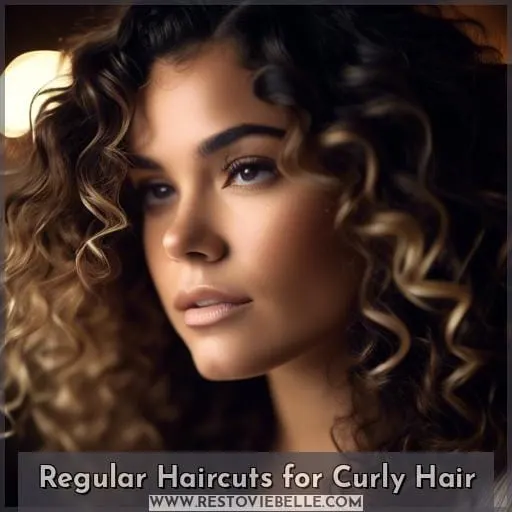This site is supported by our readers. We may earn a commission, at no cost to you, if you purchase through links.
 A stitch in time saves nine, they say, and when it comes to your curly hair, this couldn’t be truer.
A stitch in time saves nine, they say, and when it comes to your curly hair, this couldn’t be truer.
Brushing your curls can be a high-stakes game of maintaining their bounce or inviting frizz and breakage.
Should you brush curly hair? Absolutely, but with the right tools and techniques. Here’s how to keep your curls tangle-free and thriving, ensuring every day is a great hair day.
No, you should not brush curly hair with a traditional brush as it can cause breakage, damage, and frizz. Instead, use a wide-tooth comb or fingers to detangle when the hair is wet and conditioned.
Table Of Contents
- Key Takeaways
- Brushing Curly Hair: Pros and Cons
- Choosing the Right Tools
- Wet Brushing Technique
- Avoiding Frizz When Brushing
- Nighttime Hair Protection
- Salon Styling Considerations
- Scalp and Hair Hygiene
- Styling and Maintenance
- Refreshing Curls Without Water
- Regular Haircuts for Curly Hair
- Frequently Asked Questions (FAQs)
- How does the porosity of curly hair affect the choice of detangling products?
- Can certain dietary changes or supplements improve the manageability of curly hair?
- What are the environmental factors that can contribute to tangling in curly hair, and how can they be mitigated?
- How does the hardness of water in one’s area affect the health of curly hair and the effectiveness of detangling?
- Are there any specific techniques for detangling curly hair that is transitioning from chemically treated to natural?
- Conclusion
Key Takeaways
- Brush curly hair when it’s wet or damp to prevent frizz and damage, using a detangling brush or wide-tooth comb for best results.
- Use moisturizing or detangling products to provide slip and ease the brushing process, helping to maintain curl definition and reduce breakage.
- Work in sections and start detangling from the ends, gradually moving up to the roots, to minimize pulling and breakage.
- Protect curls at night with satin or silk coverings to prevent frizz and maintain moisture, and consider brushing or detangling only on wash days or as minimally as necessary to preserve curl integrity.
Brushing Curly Hair: Pros and Cons
Brushing curly hair can be a double-edged sword, offering both benefits and potential drawbacks.
On one hand, brushing can distribute natural oils throughout your hair, aiding in styling, removing buildup, and promoting overall hair health while preventing tangles.
However, it’s crucial to approach this with the right technique and tools to avoid causing damage. Brushes designed specifically for curly hair, featuring flexible bristles, can gently detangle knots without compromising curl integrity or causing breakage.
By incorporating moisture before brushing, starting from the ends and working your way up, and styling with care, you can maintain your curls’ health and definition.
Distributes Natural Oils
Brushing your curly hair can be beneficial as it helps distribute natural oils from your scalp throughout your hair. These oils are essential for maintaining moisture, promoting scalp health, and supporting healthy hair growth.
Proper brushing also aids in tangle prevention, which can reduce hair breakage and help maintain your curl pattern.
- Scalp health is crucial for healthy hair growth.
- Natural oils moisturize and protect your curly hair.
- Tangle prevention minimizes hair breakage.
- Brushing can enhance your curl pattern.
- Always brush gently to avoid damaging curls.
Aids in Styling
Brushing your curly hair can aid in styling by helping to define your curls and make them more manageable. When you brush, you’re also able to evenly distribute products, such as leave-in conditioners or detangling sprays, which can enhance curl definition and control frizz.
| Hair Type | Brush Type |
|---|---|
| Fine Hair | Bamboo Hair Pick |
| Wavy Hair | Wide-Tooth Comb |
| Thick Hair | Paddle Brush |
| All Types | Detangling Brush |
Remember to always start with wet or damp hair and work your way up from the ends to the roots to minimize breakage. Regular use of a leave-in conditioner can also improve hair health and ease the styling process.
Removes Buildup
When removing buildup from curly hair, opt for gentle brushing techniques using a wide-tooth comb or a soft-bristled brush.
Incorporate hydrating mists or leave-in conditioners to maintain moisture.
Avoid damage by choosing the right brush type and following a proper hair care routine.
Promotes Hair Health
Brushing curly hair isn’t just about detangling; it’s also a key step in promoting hair health.
- Distributing natural oils from your scalp throughout your hair, which can help to moisturize and condition your curls.
- Removing buildup from products and dead skin, which can keep your scalp and hair cleaner.
- Aiding in styling, as brushing can help define curls and prepare them for products or hairstyles.
- Encouraging hair health by stimulating the scalp, which can promote hair growth and vitality.
Prevents Tangles
Brushing curly hair can prevent tangles, but it’s crucial to use the right detangling techniques to maintain curl definition and prevent frizzy or damaged hair. Start with wet hair and work from the ends to the roots using a brushing technique that’s gentle to avoid breakage.
| Pros of Brushing Curly Hair | Tools and Techniques | Maintenance Tips |
|---|---|---|
| Distributes natural oils | Use a wide-tooth comb | Detangle regularly |
| Aids in styling | Start at the ends | Use leave-in conditioner |
| Removes buildup | Avoid brushing dry hair | Trim split ends |
Choosing the Right Tools
When it comes to managing curly hair, choosing the right tools is crucial for maintaining healthy, tangle-free curls.
Detangling brushes with flexible bristles are specifically designed to navigate through curls gently, minimizing damage and preserving the integrity of each curl. These brushes adapt to the unique patterns of your hair, ensuring knots are eased out without pulling or breaking strands, making them a suitable choice for all curl types.
Benefits of Detangling Brushes
After understanding the pros and cons of brushing curly hair, it’s crucial to choose the right tools for detangling.
- Detangling Brushes: Designed with flexible bristles, these brushes adapt to your hair’s pattern, preserving natural curls and curl definition without causing breakage.
- Comb Type Matters: A wide-tooth comb or bamboo brush gently separates knots, especially when used with a detangling spray or leave-in conditioner.
- Hair Pick: Ideal for fluffing roots without disrupting curl patterns.
- Detangling Products: Pairing the right comb type with detangling products tailored to your hair type ensures smoother, tangle-free curls.
Flexible Bristles for Curl Integrity
When choosing the right tools for your curly hair, it’s crucial to opt for those that protect your curl integrity. Brushes with flexible bristles are your allies in this mission. They adapt to the unique pattern of your curls, allowing you to detangle without causing undue stress and breakage.
This is essential for frizz control and maintaining the natural shape of your curls. When you’re styling, whether it’s with a blow dryer or hot rollers, these brushes help minimize curl damage. And when your hair is dry, a brush with flexible bristles can gently coax your curls into place without disrupting their natural form.
Wet Brushing Technique
When it comes to managing curly hair, the wet brushing technique is a game-changer. Starting with wet or damp hair allows for easier detangling and minimizes damage, as the hair’s elasticity is increased when wet.
By brushing from the ends and working your way up to the roots, you ensure a gentle approach to untangling knots, making the process smoother and less stressful for both you and your curls.
Start With Wet or Damp Hair
When transitioning from selecting the right tools for your curly hair, it’s crucial to understand the significance of starting with wet or damp hair. This approach isn’t just about preventing damage; it’s about embracing your hair’s natural texture and ensuring each curl is treated with the care it deserves.
Before you even think about brushing, make sure your hair is prepped with a leave-in conditioner or a detangling spray. This step is vital as it provides the necessary slip to reduce friction, minimizing the risk of hair tugging and shedding.
Brush From Ends to Roots
When tackling the challenge of brushing curly hair, starting with the right technique is crucial. Wet brushing, a method where you brush your hair while it’s wet or damp, is highly recommended for those with curly locks.
This approach minimizes damage and helps maintain the natural curl pattern. Before you begin, apply a leave-in conditioner or curl cream to ensure your hair has enough slip, reducing the risk of breakage.
Using a detangling spray can also add an extra layer of protection and ease the process.
Opt for a wide-tooth comb or a detangling comb designed for wet hair to gently work through knots. Begin at the ends of your hair, slowly working your way up to the roots. This method prevents unnecessary pulling and damage.
For those with particularly stubborn tangles, applying more detangling spray or conditioner can help. Remember, the goal is to preserve your curls’ integrity, making them bouncy and defined.
By brushing from the ends and moving upwards, you ensure the least amount of stress on your hair. This technique is especially beneficial for the top layers of hair, which are often more prone to frizz and damage.
Wet brushing not only helps detangle but also evenly distributes products throughout your curls, ensuring each strand is nourished and protected.
Avoiding Frizz When Brushing
To keep your curls looking their best and avoid frizz when brushing, consider reducing how often you shampoo your hair. Over-washing can strip your hair of its natural oils, leading to dryness and frizz.
Instead, seal in moisture and protect your curls by using a hair oil. This can help maintain the integrity of your curls and keep them defined and smooth.
Reduce Shampoo Frequency
Curly hair requires a delicate balance of moisture and gentle handling to maintain its health and beauty. Over-washing with harsh shampoos can strip away natural oils, leading to dryness, frizz, and breakage.
To avoid these issues, it’s crucial to reduce shampoo frequency, especially for those with curly textures. Opting for sulfate-free shampoos and clarifying conditioners can significantly improve the condition of your curls by preserving natural oils and enhancing hydration.
Co-washing, or conditioner washing, is a method that uses a conditioning cleanser to gently clean the hair without the harsh effects of sulfates. This technique helps maintain curl hydration and scalp health, promoting hair growth while minimizing damage.
When you do shampoo, choosing products that are gentle on the scalp and hair is essential. Look for sulfate-free options that include nourishing ingredients to support scalp treatments and hair tools designed for curly hair, such as a shower brush for scalp exfoliation.
Incorporating a clarifying shampoo into your routine once a month can help remove buildup without over-stripping, ensuring your scalp and hair remain healthy. Additionally, staying hydrated by drinking plenty of water can support hair growth and scalp health from the inside out.
By adjusting your co-washing frequency and being mindful of the products you use, you can keep your curls well-moisturized, reduce frizz, and promote overall hair health.
Seal With Hair Oil
To combat frizz when brushing curly hair, sealing with hair oil is key. Choose oils with ingredients that cater to your hair’s needs, whether it’s for dryness, growth, or scalp health.
Brands like Kérastase and Aussie offer top-rated options. Apply hair oil to damp hair, starting from the ends and working towards the scalp, to lock in moisture and enhance shine. This technique not only tames frizz but also maintains the integrity of your curls.
Avoid hooded dryers and let your curls set naturally for the best results. Regular haircuts can further prevent breakage and encourage healthy hair growth. Remember, the right hair oil can make all the difference in your curl-amplifying routine.
Nighttime Hair Protection
To ensure your curls look their best in the morning, it’s crucial to protect them at night.
Covering your hair with a satin-lined head covering can prevent frizz and maintain your style while you sleep.
These coverings help reduce friction and breakage, keeping your curls intact and ready for the next day.
Cover Hair to Prevent Frizz
Continuing from reducing shampoo use to combat frizz, let’s focus on nighttime hair care.
- Slip on a satin bonnet or night cap to reduce friction.
- Opt for silk sheets, which are gentler on your hair.
- Wrap your curls in a soft head wrap to maintain moisture.
- Consider a wave cap to keep your style intact.
- Choose materials that allow your hair to breathe, preventing sweat-induced frizz.
Use Satin-Lined Head Coverings
When it comes to protecting your curls at night, satin-lined head coverings are your best ally. Opt for a satin bonnet or sleep bonnet to shield your hair from the friction that traditional pillowcases can cause.
This simple switch can make a significant difference in maintaining your hair’s moisture and preventing tangles and breakage. If a bonnet isn’t your style, a satin pillowcase offers a smooth surface for your curls to rest against, reducing the chance of frizz and keeping your hair looking fresh for the next day.
For those who prefer to keep their hair tied up at night, a hair scarf made of satin can also be a gentle way to keep your curls in place without causing damage. Remember, the key is to choose accessories that will help preserve your curls’ health and appearance while you sleep.
Salon Styling Considerations
When visiting a salon for styling, it’s crucial to consider how your curls are treated to maintain their health and appearance.
Avoiding hooded dryers and allowing your curls to set naturally are key practices recommended by experts. Hooded dryers can be too harsh on delicate curls, leading to damage and frizz, while letting curls dry naturally helps preserve their shape and integrity.
These tips ensure your curls look their best, emphasizing the importance of gentle handling and the right techniques for curly hair care.
Avoid Hooded Dryers
When it comes to styling your curly hair at the salon, it’s wise to avoid hooded dryers. While they’re great for setting certain hairstyles, they’re not the best choice for your curls.
Hooded dryers work by evaporating moisture, which is counterproductive for curly hair that thrives on hydration. Excessive heat can leave your curls brittle and dry, leading to damage that’s hard to reverse.
Instead, embrace air drying to allow your curls to retain the moisture they need. If you must use heat, limit it to once or twice a week and always apply a heat protectant.
Allow Curls to Set Naturally
Continuing from the discussion on avoiding hooded dryers, it’s crucial to let your curls set naturally for optimal health and definition. After stepping away from harsh drying methods, embrace the air-drying process. This technique not only spares your strands from potential heat damage but also preserves the natural pattern of your curls.
At night, implement a hair care routine that includes satin-lined head coverings to combat frizz. These coverings help maintain moisture and reduce friction, which can disrupt curl formation. Additionally, using the right hair care products before bed, such as leave-in conditioners or oils, can further enhance curl definition and moisture retention.
When brushing, adopt a technique that minimizes frizz. Start with wet or damp hair and use a wide-tooth comb or a detangling brush with flexible bristles to gently work through knots from the ends up to the roots.
This method helps maintain the integrity of your curls and prevents unnecessary breakage.
Scalp and Hair Hygiene
Maintaining the health of your scalp is crucial for nurturing strong, vibrant curls.
Incorporating a monthly clarifying shampoo into your routine helps remove buildup, ensuring your scalp and hair remain clean and balanced.
A weekly thorough cleansing is also essential, as it keeps your scalp fresh and prevents the accumulation of products and oils that can hinder hair growth and health.
This approach not only promotes a healthier scalp environment but also supports the overall vitality of your curly hair.
Monthly Clarifying Shampoo
Transitioning from the topic of salon styling, it’s crucial to address the importance of scalp and hair hygiene, particularly the role of monthly clarifying shampoo.
- Removes Product Buildup: Over time, styling products, oils, and environmental pollutants accumulate on your scalp and hair. A clarifying shampoo effectively removes this buildup, preventing scalp irritation and ensuring your curls remain bouncy and defined.
- Promotes Scalp Exfoliation: Regular use of clarifying shampoo aids in scalp exfoliation, removing dead skin cells and unclogging hair follicles. This process is vital for healthy hair growth and maintaining a healthy scalp environment.
- Prevents Curl Damage: By eliminating residue that weighs down curls, clarifying shampoo helps maintain curl integrity. This prevention of buildup ensures your curls stay lively and less prone to damage.
- Enhances Product Efficacy: Cleansing your hair with a clarifying shampoo once a month resets your hair’s natural state. This allows your regular hair care products to penetrate better and work more effectively, leading to healthier, more manageable curls.
Incorporating a clarifying shampoo into your monthly hair care routine is a simple yet impactful way to ensure your curls remain healthy, vibrant, and free from damaging buildup.
Weekly Thorough Cleansing
To maintain the health of your curly hair, it’s crucial to cleanse it thoroughly on a weekly basis. This doesn’t mean just a quick wash; you need a regimen that removes buildup without stripping your hair of its natural oils.
Start by selecting a sulfate-free shampoo that matches your hair’s needs—hydrating formulas work wonders for dry or damaged curls. When you shampoo, avoid tangling your hair by massaging the product gently from roots to ends in a smooth motion.
After shampooing, apply a conditioner that caters to your curl type. For example, tighter curls may require a richer conditioner applied closer to the scalp, while looser curls might need it only on the ends to avoid weighing them down.
Use your fingers or a wide-tooth comb to detangle, starting from the ends and working your way up to prevent breakage and minimize curl damage.
Styling and Maintenance
When it comes to styling and maintaining curly hair, it’s crucial to avoid brushing it while dry. Brushing dry curls can lead to breakage and frizz, undermining your hair’s health and appearance.
Instead, wait until your hair is completely dry after styling to ensure you’re treating your curls with the care they deserve.
Avoid Brushing Dry Hair
Continuing from the importance of maintaining a clean and healthy scalp, let’s talk about why you should avoid brushing your hair when it’s dry.
Dry brushing can be harsh on your curls, leading to breakage and a frizzy appearance. Instead, comb wet hair gently with a wide-tooth comb or use your fingers, starting from the ends and working your way up to prevent tangles and minimize damage.
It’s also wise to brush less often and steer clear of hot tools, which can further stress your strands. When you do brush, opt for detangling products that provide slip and reduce friction, and avoid hair oils that can weigh down your curls.
Style After Hair is Completely Dry
When your curls are completely dry, it’s the perfect time to style them. This approach helps prevent excess breakage and ensures your curls maintain their natural bounce and definition.
- Apply a leave-in conditioner to nourish and protect your strands, laying the groundwork for a smooth style.
- Reach for a detangling spray to ease any lingering knots, ensuring a seamless glide when you style.
- Use a wide-tooth comb to gently shape and define your curls, starting at the ends and working your way up to avoid unnecessary stress on your hair.
By following these steps, you’ll keep your curls looking their best and reduce the risk of damage. Remember, patience is key—rushing can lead to frizz and breakage, so take your time to achieve those envy-inducing curls.
Refreshing Curls Without Water
When looking to refresh your curls without water, it’s essential to reach for water-free products and never skip the conditioning step.
These strategies help maintain your hair’s moisture balance and definition without the need for a full wash. Water-free products, like curl milk treatments, offer a convenient way to redefine and soften your curls, while conditioning keeps them nourished and manageable, ensuring your curls look their best even between washes.
Use Water-Free Products
Continuing from the importance of avoiding brushing dry hair to maintain your curls:
Let’s delve into the benefits of water-free products for refreshing your curls. These waterless maintenance options, like water-free balms and creams, are a game-changer for curly hair care. They allow you to redefine and moisturize your curls without the need for water, which can be especially useful on non-wash days.
Deep conditioning treatments are also crucial; they infuse your hair with the necessary hydration, enhancing curl definition and health.
At night, ensure you’re using satin protection like a satin pillowcase or head covering to safeguard your curls against frizz and dryness. This nighttime protection helps maintain the moisture and shape of your curls, so you wake up with your hair still looking fresh and defined.
Never Skip Conditioning
Maintaining the hydration of your curly hair is crucial, especially when refreshing your curls without water. Skipping conditioning isn’t an option if you want to keep your curls looking their best.
- Conditioning frequency is key to balancing moisture and preventing dryness. Regular use of leave-in treatments can significantly improve hair texture and elasticity.
- Leave-in treatments offer a practical solution for daily moisture without heavy rinsing, keeping curls hydrated and defined.
- Deep conditioning sessions are essential for penetrating the hair shaft and providing intense hydration, which is especially beneficial for curly hair prone to dryness.
- Co-washing benefits include maintaining moisture levels while gently cleansing the scalp, making it a great alternative to traditional shampoos for curly hair types.
- Homemade masks can provide a cost-effective, natural way to infuse your hair with moisture and nutrients, using ingredients like avocado, honey, and coconut oil.
By incorporating these practices into your hair care routine, you’ll ensure your curls remain hydrated, healthy, and vibrant, even without the use of water.
Regular Haircuts for Curly Hair
Getting regular haircuts is crucial for maintaining the health and vitality of your curly hair. Trims help prevent breakage by removing split ends, which can otherwise travel up the hair shaft, causing more damage.
Additionally, cutting your hair regularly promotes healthy growth, ensuring your curls look their best.
Trims Prevent Breakage
Maintaining the health of your curly hair isn’t just about the products you use or how you style it; regular trims play a crucial role too. Just as you’ve learned to refresh your curls without relying on excessive water, understanding the importance of trimming is key to preventing breakage and promoting hair health.
Split ends are more than just a nuisance; they can lead to further damage if left unattended. Regular trims, therefore, aren’t just about keeping your hair looking good—they’re about keeping it healthy.
Salon visits for trims should be scheduled based on the unique needs of your hair. While a general guideline suggests every 3-4 months, pay attention to the telltale signs your curls give you. If you notice increased tangles, a lack of definition, or simply that your ends feel rough and dry, it’s likely time for a trim.
This doesn’t mean you’ll lose length; rather, by trimming damage and split ends, you’re ensuring that your hair can grow healthier and stronger.
Promote Healthy Growth
To promote healthy growth in curly hair, regular haircuts are essential. They not only remove damaged ends but also encourage stronger, healthier hair.
-
Trim Regularly: Aim for a trim every 6-8 weeks. This helps prevent split ends from traveling up the hair shaft, which can lead to more breakage and less definition in your curls.
-
Choose the Right Stylist: Find a stylist experienced with curly hair. They’ll understand how to cut curls so that they fall naturally and beautifully, maintaining your hair’s shape and volume.
-
Communicate Your Goals: Before the scissors come out, discuss your hair goals with your stylist. Whether it’s maintaining length or encouraging volume, clear communication ensures you leave the salon happy.
Incorporating these steps into your hair care routine, along with proper brushing techniques, using recommended products, and maintaining scalp health, won’t only detangle curly hair but also ensure it grows out strong and healthy.
Frequently Asked Questions (FAQs)
How does the porosity of curly hair affect the choice of detangling products?
High porosity hair absorbs moisture quickly but struggles to retain it. This type of hair necessitates heavier products like oils or butters to lock in hydration.
Conversely, low porosity hair resists moisture absorption. This type of hair requires lightweight, water-based products to penetrate and hydrate effectively.
Can certain dietary changes or supplements improve the manageability of curly hair?
Incorporating omega-3s, vitamins A, C, E, and biotin into your diet can enhance your curly hair’s health and manageability.
What are the environmental factors that can contribute to tangling in curly hair, and how can they be mitigated?
Humidity, wind, and pollution can lead to tangling in curly hair.
Combat these by using protective styles, moisturizing products, and avoiding harsh elements when possible.
How does the hardness of water in one’s area affect the health of curly hair and the effectiveness of detangling?
Hard water, rich in minerals like calcium and magnesium, can make detangling curly hair more challenging.
These minerals build up on your hair, leading to dryness, reduced moisture penetration, and increased breakage.
To combat this, consider using a chelating shampoo or installing a shower filter to minimize mineral buildup, ensuring your curls remain healthy and manageable.
Are there any specific techniques for detangling curly hair that is transitioning from chemically treated to natural?
For transitioning curly hair, gently detangle with a wide-tooth comb or fingers, starting from the ends and moving upwards.
Use a moisturizing conditioner or detangling spray to ease the process.
Avoid brushing dry hair to prevent breakage.
Conclusion
As the old saying goes, forewarned is forearmed, especially when it comes to managing your curls.
Brushing curly hair doesn’t have to be a daunting task if you’re equipped with the right knowledge and tools. Remember, the key to tangle-free, vibrant curls lies in gentle detangling with appropriate instruments, maintaining hydration, and protecting your locks at night.
By following these expert tips, you’ll ensure your curls remain healthy, bouncy, and beautiful, proving that a stitch in time truly does save nine.

